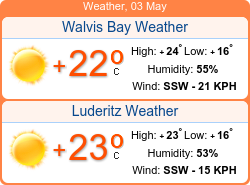Namport awes African ambassadors

By Magreth Nunuhe
Walvis Bay – The Chief Executive Officer of the Namibian Ports Authority (Namport), Bisey /Uirab, has called on Africans to do business among themselves, empower each other and ensure trade relations are strengthened.
“We do not do enough business among ourselves. Let’s see what we can do better,” said /Uirab, when he addressed a high-powered delegation of African ambassadors who took a tour of the Namport facility in Walvis Bay on 5 October 2017.
He said it was the task of foreign missions to develop and strengthen ties for economic development.
Namport is connected with good shipping services that provide an option for shippers from Europe and North America to supply bulk, containerised and breakbulk shipments such as abnormal loads to neighbouring countries in the Southern African region in the shortest possible time.
The heavy-lift port facilities remove the requirements for road permits or abnormal clearances between the quayside and the storage yard which streamlines the process for customers.
It has also become an important node for Southern Africa as minerals through the port from land-locked countries increase.
Leading the delegation during the visit to Namport, the South African High Commissioner to Namibia, Yvette Myakayaka-Manzini, said that the visit was to solidify relations they have at various levels, such as the SADC and at bilateral levels.
“The Walvis Bay area is dealing with transport, shipping, logistics, dry ports. We don’t have dry ports. The visit is to have an idea and visualise the development of Walvis Bay,” she said.
Myakayaka-Manzini stressed the importance of Namport to SADC as it alleviates traffic congestion for Durban and Cape Town in South Africa, while giving landlocked countries access to the sea to transport their goods.
“The ocean economy is one of the nine points identified to grow the economy. We realise that during apartheid, the economy was left to other people,” she noted, adding that Africans have now begun to prioritise economic activities by trading among themselves.
Zimbabwean ambassador Rofina Chikava said she could see that Africa was developing.
“The projects in Namibia are not only for Namibia but the whole of Africa. We will support Namibia to create more employment for our people. I know Zimbabwe delayed, but we are at a point where we can use the dry port,” she pointed out.
Namibia granted Zimbabwe land for a dry port in 2009 at the Walvis Bay harbour.
Zambian Ambassador Stella Libongani said it was a wonderful tour and an opportunity for diplomats to know about developments that have an impact on trade in SADC, Africa and beyond.
“For Zambia, a landlocked country, we are very grateful to have been given space at the port – the dry port facility. That facility is opening our routes and we are making use of it,” she said.
Libongani said that Zambia has been doing quite considerable import and export activities since the opening of the Zambian dry port, especially for goods in transit.
“We foresee trade facilitation to grow as we expand the dry port,” she added.
Zambian is able to link traders at its dry port facility on 30 152 square metre of land that has been operational for almost six years now.
Botswana’s High Commissioner, Tshenelo Modise, said that she was very proud of the developments taking place at Namport, “for someone coming from a landlocked country”.
“It makes us happy to see that we are at the right place at the right time,” she added, assuring that she would boost the image of Namport, the Botswana dry port and the Trans-Kalahari Highway to her country men and women.
Modise was not only impressed by Namport but by the rest of the activities happening around the coastal area, such as the newly opened Husab uranium mine, which is considered to be the largest in the country and how vibrant communities in the vicinity were making best use of resources in the area. The Botswana dry port was completed in 2014 and is now fully operational and handles both breakbulk and containerised cargo.
The dry port covers 36 200 square metres of land at the Walvis Bay’s deep sea harbour, handles 80 000 tonnes of goods, has a general warehouse, 300 parking bays and handling 4 800 cars annually.
Nigeria High Commission’s second secretary, Opara Kelechi, was equally impressed with the visit to the Namibian coast, saying that touring Namport was quite an eye-opener.
“Africans can trade among themselves and be prosperous,” he said, adding that they do not need Europe or other countries outside Africa in order to succeed and that leaders could through good governance keep what belongs to Africa in Africa.
Kelechi said that Namibia can, for instance, trade with Nigeria by exporting fish and uranium to that country.
“Through Walvis Bay, a lot of economic activities can have impact on Nigeria,” he added.
Namibia’s western coast deep water port is a natural gateway for regional trade as it offers direct trade links to countries in Southern Africa with the rest of the world.
The port receives more than 3000 vessels, moves about 5000 tonnes of cargo and has the potential to accommodate up to 350 000 containers per year.
Namport’s trade routes stretch through Botswana, Zimbabwe, Angola, Zambia, Malawi and other land-locked countries in SADC.
Some of the goods trafficked into the SADC region are building materials, vehicles, petroleum products, electrical equipment, frozen fish, ship spares, spare parts, copper, zinc, and machinery.


